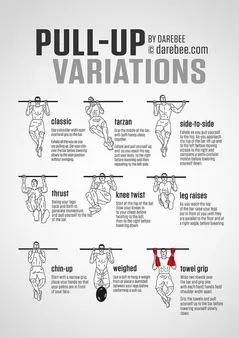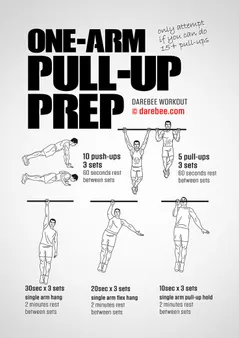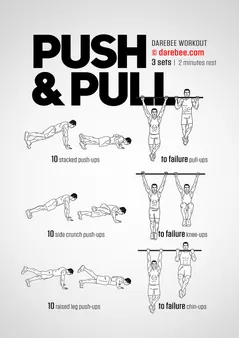Table of Contents
Are you ready to take your workout to the next level with a pull calisthenics workout? Whether you're a seasoned pro or just starting out, Kizworld has got you covered. In this article, we'll guide you through everything you need to know about pull calisthenics, from the basics to advanced exercises. Get ready to build strength, improve mobility, and unleash your inner athlete with kizworld's advice on pull calisthenics workouts.
The Ultimate Guide to Pull Calisthenics Workout: Transforming Your Back and Biceps
Benefit | Exercise | Difficulty |
|---|---|---|
Increased upper body strength | Pull-ups | Beginner |
Improved grip strength | Chin-ups | Beginner |
Enhanced back development | Inverted rows | Intermediate |
Improved core stability | Dragon flags | Advanced |
Increased flexibility | Muscle-ups | Advanced |
I. Exercises included in a pull-focused calisthenics workout
Pull-ups
Pull-ups are a compound exercise that works multiple muscle groups in the upper body, including the back, biceps, and forearms. They are a great way to build strength and muscle mass. To perform a pull-up, grab a pull-up bar with an overhand grip, shoulder-width apart. Pull yourself up until your chin is above the bar, then slowly lower yourself back down.How to do a pull-up
Chin-ups
Chin-ups are another compound exercise that works multiple muscle groups in the upper body, including the back, biceps, and forearms. They are similar to pull-ups, but they are performed with an underhand grip. This grip variation targets the biceps more than the back. To perform a chin-up, grab a pull-up bar with an underhand grip, shoulder-width apart. Pull yourself up until your chin is above the bar, then slowly lower yourself back down.How to do a chin-up
Inverted rows
Inverted rows are a great exercise for building strength in the back and biceps. They are also a good option for people who cannot perform pull-ups or chin-ups. To perform an inverted row, find a sturdy object that is about waist-height. Place your hands on the object, shoulder-width apart, with your body in a straight line from your head to your heels. Pull yourself up until your chest touches the object, then slowly lower yourself back down.How to do an inverted row
Exercise | Difficulty | Benefits |
|---|---|---|
Pull-ups | Beginner | Increased upper body strength, improved grip strength, enhanced back development |
Chin-ups | Beginner | Improved grip strength, enhanced back development, increased biceps strength |
Inverted rows | Intermediate | Increased upper body strength, improved grip strength, enhanced back development |
Exercises included in a pull-focused calisthenics workout
II. Benefits of a pull calisthenics workout
Improved upper body strength
Pull calisthenics exercises are a great way to build upper body strength. They work your back, shoulders, arms, and chest. Some of the most popular pull calisthenics exercises include pull-ups, chin-ups, inverted rows, and muscle-ups. These exercises can be done with just your bodyweight, so they're a great option for people who don't have access to a gym.
Exercise | Benefits | Difficulty |
|---|---|---|
Pull-ups | Works back, shoulders, arms, and chest | Beginner |
Chin-ups | Works biceps and back | Beginner |
Inverted rows | Works back and shoulders | Intermediate |
Muscle-ups | Works entire upper body | Advanced |
If you're new to pull calisthenics, start with some of the easier exercises, such as pull-ups and chin-ups. As you get stronger, you can progress to more challenging exercises, such as inverted rows and muscle-ups. Pull calisthenics exercises can be a great way to improve your upper body strength and build a more muscular physique.
Enhanced back development
Pull calisthenics exercises are also a great way to enhance back development. Your back is responsible for supporting your entire body, so it's important to have a strong back. Pull calisthenics exercises can help you to develop a stronger, more muscular back, which can help to improve your posture and reduce your risk of back pain.
- Pull-ups are a great way to work your lats, which are the large muscles on the sides of your back.
- Chin-ups are a great way to work your upper back, including your traps and rhomboids.
- Inverted rows are a great way to work your lower back, including your erector spinae.
If you're looking to improve your back development, pull calisthenics exercises are a great option. They're effective, challenging, and can be done anywhere. With regular practice, you can develop a stronger, more muscular back that will help you to look and feel your best.
Improved core stability
Pull calisthenics exercises can also help to improve core stability. Your core is responsible for stabilizing your spine and pelvis, and it's important for overall balance and coordination. Pull calisthenics exercises can help to strengthen your core muscles, which can help to improve your posture and reduce your risk of back pain.
Some of the best pull calisthenics exercises for core stability include dragon flags, leg raises, and toes-to-bar. These exercises challenge your core muscles to stabilize your body while you're moving.
If you're looking to improve your core stability, pull calisthenics exercises are a great option. They're challenging, effective, and can be done anywhere. With regular practice, you can develop a stronger, more stable core that will help you to move better and feel better.
Benefits of a pull calisthenics workout
III. How to customize a pull-weighted calisthenics workout
Choose the right exercises
The first step is to choose the right exercises for your workout. If you're a beginner, start with some basic exercises like pull-ups, chin-ups, and inverted rows. As you get stronger, you can add more challenging exercises like dragon flags and muscle-ups.
Adjust the weight
Once you've chosen your exercises, you need to adjust the weight. You can do this by adding weight to your body with a weight vest or backpack. You can also use resistance bands to increase the difficulty of your exercises.
Increase the reps or sets
If you want to make your workout more challenging, you can increase the number of reps or sets you do. For example, instead of doing 3 sets of 10 reps, you could do 4 sets of 12 reps.
Change the tempo
You can also change the tempo of your exercises to make them more challenging. For example, instead of doing your exercises at a normal pace, you could try doing them slowly or explosively.
Add variety
To keep your workouts interesting, add variety to your routine. You can do this by changing the exercises you do, the weight you use, the reps or sets you do, or the tempo of your exercises.
Exercise | Difficulty | Benefits |
|---|---|---|
Pull-ups | Beginner | Increased upper body strength, improved grip strength |
Chin-ups | Beginner | Improved grip strength, enhanced back development |
Inverted rows | Intermediate | Enhanced back development, improved core stability |
Dragon flags | Advanced | Improved core stability, increased flexibility |
Muscle-ups | Advanced | Increased flexibility, improved grip strength |
By following these tips, you can customize a pull-weighted calisthenics workout that is tailored to your fitness level and goals. So what are you waiting for? Get started today and see the amazing results you can achieve!
Here are some additional tips for safely performing pull-focused calisthenics exercises:
- Always warm up before your workout.
- Use proper form to avoid injury.
- Listen to your body and stop if you feel pain.
- Progress gradually to avoid overtraining.
- Have fun!
If you have any questions or concerns, be sure to consult with a qualified fitness professional.
Related posts:
- How to Do a Muscle-Up
- The Best Calisthenics Gifts and Accessories
- The Best Calisthenics Quotes and Motivation
How to customize a pull-weighted calisthenics workout
IV. Tips for safely performing pull-focused calisthenics exercises
Warm up properly
Before you start any pull-focused calisthenics exercises, it is important to warm up properly. This will help to prevent injuries and prepare your muscles for the work ahead. Some good warm-up exercises include light cardio, dynamic stretching, and activation exercises for the muscles you will be using.
Use proper form
When performing pull-focused calisthenics exercises, it is important to use proper form. This means keeping your back straight, engaging your core, and using a full range of motion. Using proper form will help to maximize the benefits of the exercises and prevent injuries.
Listen to your body
If you feel any pain while performing pull-up exercises, stop and rest. Pushing through pain can lead to injuries. It is important to listen to your body and rest when needed.
Progress gradually
Do not try to do too much too soon. Start with a few repetitions of each exercise and gradually increase the number of repetitions as you get stronger.
Exercise | Difficulty | Benefits |
|---|---|---|
Pull-ups | Beginner | Increased upper body strength, improved grip strength, enhanced back development |
Chin-ups | Beginner | Improved grip strength, enhanced back development, increased biceps strength |
Inverted rows | Intermediate | Enhanced back development, improved core stability, increased shoulder strength |
Dragon flags | Advanced | Improved core stability, increased lower back strength, enhanced hip flexor flexibility |
Muscle-ups | Advanced | Increased upper body strength, enhanced back development, improved grip strength |
For more information on calisthenics, you can check our article Calisthenics: Achieving Fitness Excellence with Bodyweight Training.
Tips for safely performing pull-focused calisthenics exercises
V. Conclusion
Congratulations on completing your pull calisthenics workout! 💪 You should be proud of yourself for pushing your limits and challenging your body. Remember, consistency is key, so try to stick to your workout routine as much as possible. As you continue to train, you will get stronger and see even more amazing results. Keep up the great work!